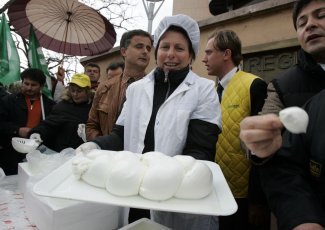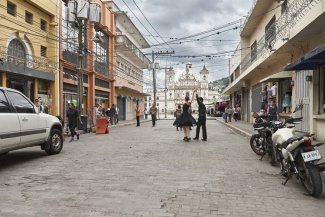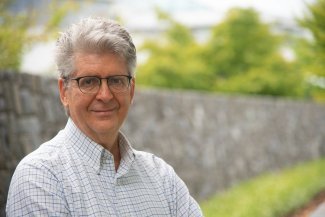At the No Mafia Memorial in Palermo, a wall of photo portraits pays tribute to the innocent victims of organised crime, 8 May 2022.
Some Sicilians say that their island is a land of contradictions. To see this for yourself, all you have to do is wander through the streets of its capital, Palermo. Overrun by tourists, both in summer and winter, you often have to elbow your way through the crowded alleyways around Via Maqueda, where street food and souvenir shops overlap. On the stalls of the street vendors, the figure of Vito Corleone, the ‘Godfather’ in Francis Ford Coppola’s film, is still ever present. And for good reason: Sicily, the backdrop of the Hollywood trilogy, is the cradle of Cosa Nostra, a powerful mafia with a sprawling network of tentacles that has earned it the nickname ‘The Octopus’.
It is also in the heart of the old town, wedged between two travel agencies, that the No Mafia Memorial was set up, in 2018, by Sicily’s Giuseppe Impastato documentation centre, named after an anti-mafia activist who was murdered in the early 1980s. At the entrance, bags and T-shirts bearing the museum’s name sell like hotcakes. “If they can compete with those of The Godfather...,” jokes Ario Mendolia, the director of the memorial. You only have to climb a few steps to understand what is really at stake.
Based on the impressive archive that the documentation centre has built up since its foundation 45 years ago, the museum offers a large free exhibition dedicated to the history of the Italian mafia and its criminal activities, with photos showing violent crime scenes or the faces of corrupt men. “It is important to deconstruct the romantic vision people have of the mafia, based on the classic iconography of the cinema. We want to show the mafia for what it really is. At the end of the visit, a couple from the United States inquires: “But isn’t it dangerous to attack the mafia like this?”
“Anti-mafia is the common good”
When the city’s former mayor, Leoluca Orlando, first pushed open the door of the Palace of the Eagles [the name of the city hall] in 1985, Palermo was destitute. “It was entirely governed by the mafia,” he recalls. “There was no option but to obey. If you obeyed, you had work, you had access to health care and you were protected.” With his ‘Palermo Spring’, he launched an operation to reconquer the territory lost, although it was not until a few years later, with the awakening of public awareness, that his policy was really able to flourish.
In 1992, anti-mafia judges Giovanni Falcone and Paolo Borsellino, former members of the anti-mafia pool that led the first ‘maxi trial’ of Cosa Nostra, were killed, a few months apart, in spectacular bombings. For the first time, the shock was nationwide.
“[These crimes] gave everyone eyes and ears. The mafia relies on silent complicity and fear for its survival. The events of 1992 cut those wires,” summarises Orlando.
Re-elected as mayor in 1993 with 75 per cent of the vote in the first round, he appointed Antonino Caponnetto, a magistrate and founder of the then dissolved anti-mafia pool, as president of the city council. “The message was clear: the mafia would no longer be governing Palermo.” The mayor already had the law on his side, which authorised the confiscation of mafia assets and recourse to the ‘repentant’ , but he wanted to go further. “The fight against the mafia has to work like a cart with two wheels, the legality wheel and the culture wheel. And these two wheels must turn at the same speed because if one turns faster than the other, the cart topples over,” explains the former mayor.
Orlando and his teams embarked on a major clean-up operation. Infrastructures ranging from the airport to the velodrome and schools were renamed in honour of victims of the mafia. “According to mafia culture, what’s mine belongs to me, what’s yours belongs to you, and what’s neither mine nor yours belongs to no one. In the culture I have tried to defend, the opposite applies: what is neither mine nor yours belongs to everyone. The mafia erects boundaries. Anti-mafia is the common good,” summarises the former mayor.
Educating the younger generation
The death of Falcone and Borsellino also raised public awareness. For, far from the cameras, thousands of Sicilians were also mourning a loved one who had been a victim of organised crime. Two anti-mafia structures were established that have become fundamental in Italy: the Falcone Foundation and the Libera anti-mafia network. Today, Libera brings together over 1,600 associations from all over Italy. Their common objective is to win back territory and minds, through remembrance of the victimshttps://vivi.libera.it/it-ricerca_nomi and a culture of lawfulness.
“By portraying the victims of the mafia as resistance fighters or patriots, […] the associations are promoting an ethical value system that echoes Republican principles. The aim is to pull the rug out from under mafia culture, which rests on omertà [a code of silence] and control of the territory. It also helps restore the prestige of the state, so that young people turn to it first, especially in mafia-infested areas,” says Charlotte Moge, a mafia specialist and researcher at the Lyon 3 University in France.
In a territory plagued by poverty, it is no easy task, to say the least. Sicily is the region with the highest at-risk-of-poverty rate in Europe.
Over half of the working population is unemployed, less than 10 per cent of the island’s schools offer full-time education, leaving many teenagers to their own devices for a good part of the day. Palermo, the capital, is no exception. Be it in the old town or on the outskirts, the charm of the old stones hides the other face of the city: insalubrious housing, children missing out on education and mountains of illegally dumped waste.
“In the city centre, the poverty is extreme. People live in cars with their children, or in houses without water or electricity, sometimes with as many as 10 sharing a basement,” says Chloé Tucciarelli, a member of the Addiopizzo association, which fights against the protection money (‘Pizzo’ in Italian) racket. “If they’re not offered solutions, they’ll look for them elsewhere.”
And so, associations are trying to fill the gap in poor and underdeveloped areas well known for being controlled by Cosa Nostra, such as Zen 2, C.E.P., Sferracavallo and Ballarò, and where the Libera network is active. “The lack of leisure or educational infrastructure opens the way for trafficking [...]. Many young people fall into it, because it is the easiest option,” says Clara Triolo, a member of Libera. The Liberi di Crescere (Free to Grow) project helps teachers, families and pupils reclaim their neighbourhood, in which the school takes centre stage. The association has introduced a help desk, play activities and study support.
The No Mafia Memorial, for its part, welcomes up to four classes a day during the school year for awareness-raising workshops. From associations to local parishes, there are now dozens of structures working with young people on a daily basis.
Winning ground
The anti-mafia campaign is equipped with a valuable legal tool: Law 109, authorising public and social reuse of assets confiscated from mafia members since 1996. “They have to be redistributed to civil society, associations or cooperatives,” explains Triolo. “This allows communities to reclaim ownership of their territory through their own educational or professional projects, and to offer real alternatives.”
“The Centopassi winery (named after the film The Hundred Steps, about the life of Giuseppe Impastato), located between Palermo and Corleone, stretches over 90 hectares of land confiscated from Cosa Nostra. It is managed by the agricultural cooperatives of the Libera Terra consortium, which are making a seemingly simple commitment, to virtuous agriculture, both for the land and the workers. “But in Sicily, it represents a powerful message,” notes Moge. “It shows that it is possible to have a job that’s free, that’s declared and devoid of any links with the mafia, even in territories riddled with mafia presence. And that an alternative and virtuous economic model can be developed, even in territories plagued by unemployment and organised crime.”
The Addiopizzo association has also set up its headquarters in the former apartment of a mafia boss in the centre of Palermo. For almost two decades, it has been defending the city’s shopkeepers who want to free themselves from the pizzo racket. According to Palermo’s public prosecutor’s office, nearly 80 per cent of Palermo’s businesses were still paying it in 2003. The practice is now in decline, with less than half of traders still paying the ‘tax’ today, according to the association.
“The police have reported to us that it has listened into the mafia saying that it will not racketeer the traders in our network. This means that, today, taking a stand no longer puts you in danger, but protects you – at least in a group context,” says Tucciarelli, with satisfaction.
Since 2009, Addiopizzo has also been offering guided tours through its travel agency, visiting places that are emblematic of the anti-mafia fight. “These are small actions, but they are important in that they have tangible results and enable us to gain ground,” says Tucciarelli.
“Ground” is being won, but not yet the war. Leoluca Orlando, having reached the end of his sixth term in office, handed over his seat, last June, to the former rector of the University of Palermo, Roberto Lagalla. Whilst Orlando zealously displayed his opposition to Cosa Nostra, Lagalla has received the support of two politicians who have been heavily sentenced in the past for their collusion with the mafia. “That these people can have influence, and that the mayor has accepted it, is very serious. He has ended up distancing himself, but the message has got through,” says Tucciarelli.
According to Orlando, the future is in the hands of Palermo’s civil society, which he has watched grow for over 35 years from his municipal building, in the Palace of the Eagles. With cries of “Mafia, out of the state!”, the many demonstrations and commemorations that took place between 23 May and 19 July (dates marking 30 years since the murders of Falcone and Borsellino) attracted support from all over Italy, including Corsica, because Palermo, the cradle of Cosa Nostra, is now an inspiration for the anti-mafia struggle.













